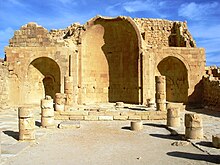This is an old revision of this page, as edited by Gilabrand (talk | contribs) at 19:14, 15 January 2009 (add article on industrial factory design). The present address (URL) is a permanent link to this revision, which may differ significantly from the current revision.
Revision as of 19:14, 15 January 2009 by Gilabrand (talk | contribs) (add article on industrial factory design)(diff) ← Previous revision | Latest revision (diff) | Newer revision → (diff)The architecture of Israel is composed of many different styles of building brought in by those who have occupied the country over the ages, sometimes modified to suit the local climate and landscape. Fortified Crusader castles, Islamic madrassas, Byzantine churches, Templer houses, Bauhaus-style modernist buildings, Arab arches and minarets, Russian Orthodox onion domes, and soaring glass-sided skyscrapers - all are part of the architecture of Israel.


The Arabs built small stone houses on the hillsides with flat or dome roofs. The Crusaders built fortresses on strategic hilltops. The Christians built churches to mark sites where Jesus walked. The Templers built homes with tiled roofs like those in the German countryside. The British Mandatory authorities passed a law requiring all construction in Jerusalem to be of Jerusalem stone and introduced the idea of garden suburbs. In the early years of statehood, Israel built rows of concrete tenements to accommodate the masses of new immigrants to replace the huts, tents and packing crates of the maabarot. Tel Aviv's White City of Tel Aviv has been declared a UNESCO World Heritage Site. Recently, skyscrapers have begun to dominate the urban landscape. The Moshe Aviv Tower in Ramat Gan is, with the height of 244m, the tallest building in Israel to date.
References
- Encyclopedia of Zionism and Israel, edited by Raphael Patai, Herzl Press, McGraw, New York, 1971 "Architecture and Town Planning in Israel," Vol. 1, pp. 71-76
This article about an Israeli building or structure is a stub. You can help Misplaced Pages by expanding it. |
External links
- A little modesty goes a long way David Kroyanker http://www.haaretz.com/hasen/spages/990951.html
- Fifty years of Israeli architecture David Kroyanker http://www.mfa.gov.il/MFA/MFA+Publications/Photo+exhibits/Fifty+Years+of+Israeli+Architecture+as+Reflected+i.htm?DisplayMode=print
- Jerusalem: Architecture in the late Ottoman Period Lili Eylon
http://www.jewishvirtuallibrary.org/jsource/Archaeology/jerott.html
- [http://www.haaretz.co.il/hasen/pages/ShArtStEngPE.jhtml?itemNo=1029311&contrassID=2&subContrassID=14&title='A%20concrete%20life%20'&dyn_server=172.20.5.5, A Concrete Life, Noam Dvir, Haaretz